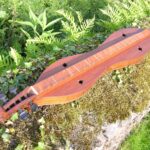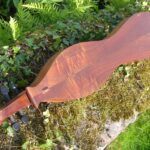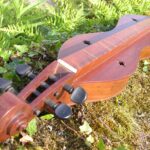Walter Martin – Sunhearth Instruments
Walter Martin (1911-1999) was a woodwork teacher and engineer from Roaring Springs, Pennsylvania. In 1970, Walt heard a dulcimer at a festival in State College, Pennsylvania, and felt an immediate attraction to it and its music. He had to have one, so he made it himself out of his grandmother’s walnut bedstead and some redwood he had lying around. It sounded so good he decided to make one for every member of the family. By then he just couldn’t let it go. He did some serious design research, and started taking the improved models around to craft fairs. His homestead (which he had designed and built himself) was called Sunhearth and that became the base for Sunhearth Folk Instruments in 1971. His designs were revolutionary for the time, with more volume, but also plenty of subtlety and great tone. Hi workmanship and attention to details was also legendary, with beautiful hand-carved scroll headstocks and tails. He attracted the interest of may big-name players of the time and Lorraine Lee Hammond in particular – with her wide range of music from blues, jazz to medieval – helped Walter develop his instruments. The top of the range model was the Concert Model. Walt made exactly 1000 appalachian dulcimers before retiring on his 80th birthday (1991). He also made some banjos and hammered dulcimers.
3.34 1975 Sunhearth 4 String Hourglass #213 £450 + £25 NEW padded case
Handwritten in pen (but as neatly as a printed label): “Sunhearth/ #213 – 8 – 16 – 75/ W. Martin”.
It has deep walnut sides and (bookmatched) back with a straight and fine-grained redwood top, decorated with Martin’s signature sun-shaped soundholes in both upper and lower bouts (plated behind to reinforce this potentially weak point); fiddle edges; 3 elegant walnut feet on back, one below headstock, two on LB (but deliberately not opposite each other). Beautiful hand-carved scrolls finishing the back at head and tail AND a proper violin-type scroll headstock with black ebony pegs. Four bone/ivory pegs for strings anchors and bone fillet at top of tail for strings to run over. Very neat ebony (?) fine tuners running on strings between bridge and tail (2 missing). 16 largish brass frets (just over 2 octaves) with no 6+ fret. High, single-piece, hollow fingerboard with long, shallow strum hollow. Damage: loss of fiddle edge at two points on far side top; two bad cracks on each side of fingerboard at the waist; no bridge, 2 fine tuners missing; general dents on fiddle edges and top. Overall length 37”, upper bout 5¾”, lower bout 7” (+⅛”?), depth 2”, FBW 1½” (- ⅛”?), VSL 27⅝” (medium scale), weight 1lb 15oz (875g). No 6+ fret.
Click on images below to enlarge.



